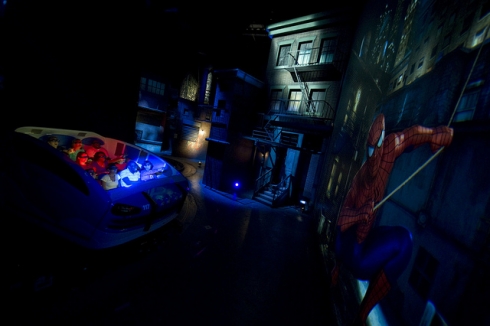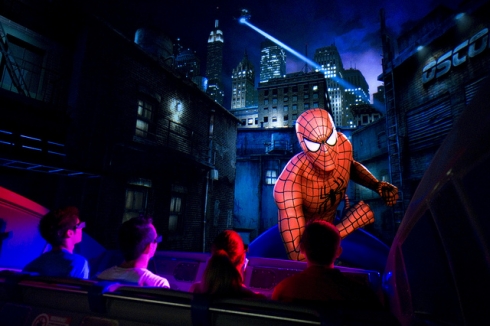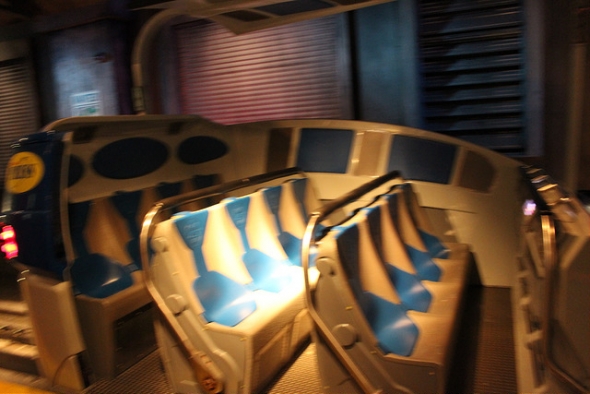The Experience: Throwing You into the Pages of a Comic Adventure
The Trick: A mobile ride cart called The Scoop
The conceit of The Amazing Adventures of Spider-Man is that you’re not the famous Webslinger himself. Instead, you’re a cub reporter about to stumble onto your big break…if you survive it. J. Jonah Jameson, the Publisher and Editor-in-Chief of The Daily Bugle needs someone to cover the story of five supervillains hijacking one of the country’s most storied artifacts. Since supervillains are callous about collateral damage, you’re the only sucker in the office willing to take the job. Everybody who isn’t working their first day on the job avoids these assignments. By running away screaming.
Jameson tells you that he’s developed a new journalistic tool that will aid you in covering the story. It’s The Scoop, the ride cart for this attraction, and it doesn’t seem to do much to keep you out of harm’s way. Still, it’s an amazing technical innovation, one that’s since become the jumping off point for several other Universal Studios attractions of similar popularity.

In building the ride, the goal was to craft a mobile attraction that would make theme park tourists feel as if they were a part of an actual Spider-Man brawl. To achieve this effect, engineers constructed mobile carts that would hit certain spots at the appropriate moments. At each location, a projector would display 3D imagery that would add the sensation of motion to the experience. Since the projected images weren’t stable in the center of the picture, they’d move in and out of the action as if they were real.
The trick was to time everything just right. Neither Universal nor any other theme park had attempted this sort of attraction before. The closest thing up until that point was Indiana Jones Adventure: Temple of the Forbidden Eye at Disneyland. As such, they had to innovate with The Scoop while also guaranteeing that their attraction vastly surpassed the competition from Disney.
The Scoop follows a new kind of track that gives more freedom of motion. The Scoop itself enjoys six different types of motion. It can spin in a circle or vibrate to simulate a ratting effect. It also can roll, pitch, and yaw. That means the cart can lean left, right, up, or down. Its independent control is why you feel a thump when Spider-Man jumps on the front of the cart or experience the sensation of plummeting 400 feet without ever really going anywhere. Fans of Universal Studios Orlando are used to this sort of motion simulation today, but it was historically unprecedented when park officials unveiled The Scoop.
The Experience: Achieving multi-dimensional visual while in motion
The Trick: You can’t have a movie without a projection screen!

You’re wearing 3D glasses throughout the ride, so you have no way to know this, but The Amazing Adventures of Spider-Man features 13 different projection screens. Engineers placed them at appropriate points throughout the attraction so that you’re always looking at a screen during the action. This required a tremendous amount of testing since (again) it was something that had never been attempted on this scale before. As you can see, the Spider-Man ride has stood the test of time since it was so revolutionary for its era.
The 13 screens aren’t placed symmetrically. Instead, Universal employees performed tests involving fog machines and lasers. They did this to identify the best locations for perfect synchronization of the ride vehicle along with the onscreen projections. Without this attention to detail, you’d hear dialogue that you couldn’t see or you’d arrive at a location too soon, causing you to watch something that wasn’t supposed to happen yet. Universal officials suggest that they spent the body of three years fine-tuning the timing between the rides and projectors since it was that difficult to perfect.
Engineers had to anticipate not only where the cart would be located during each moment of the ride but also how the view would look from within the cart. Keep in mind that 12 different people are onboard, each of them with a variant look at the projection screens in front of them. And all of them wear 3D goggles that must display the same point of view. Otherwise, riders will fall victim to blurring, which isn’t merely distracting. It can also cause dizziness in pronounced instances. Universal’s attention to detail largely made this a non-issue, although emerging technologies forced some changes.


Add new comment